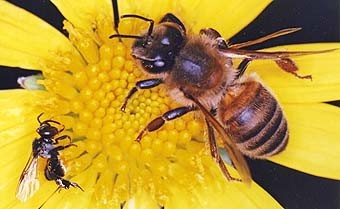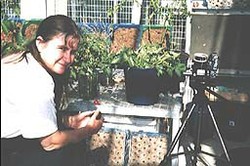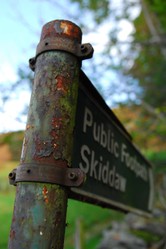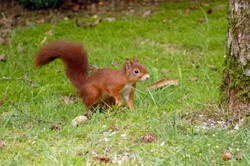Did you know that there are over 1,500 species of bees unique to Australia? These are the Australian native bees. They are unique and quite different in their characteristics to the European honey bees that most people have seen. They are also very important to Australia's environment, including for pollinating many native plants. In this article you can learn a little about these fascinating and little-known insects.

Australian Native Bees: Research and Education
by AnneDollin
A little information about Australian native bees and about Anne and Les Dollin who together have been studying the world of these fascinating bees since 1979.
Australian Native Bees
Australia is hiding a fascinating secret: its native bees!
In Australia there are more than 1,500 species of Australia native bees. They live in all parts of Australia and in all sorts of habitats -- from the tropic zones to the heathlands and to the tops of gum trees, from desert sands to straggly trees beside isolated waterholes.
These bees are quite different to the commercial honey bees (Apis mellifera) which are not native to Australia, having been imported into Australia from Europe in 1822.
Australian native bees come in many different sizes -- from the tiny Quasihesma bee of far north Queensland (it is just 2 mm long) to the largest one, the Great Carpenter Bee (which is up to 24 mm long).
They come in a rainbow-like variety of colors too: black, yellow, red, metallic green, even blue.
Most Australian native bees are solitary bees. Some 10 species are social native bees (of the genera Trigona and Austroplebeia) which have an attractive feature for us humans: they do not sting! This latter group is known as Australian stingless bees.
Anne and Les Dollin, who live in the Blue Mountains, near Sydney (Australia), are specialists in the area of Australian native bees, and since 1979 have taken on the task of doing research about these fascinating insects and of educating the general public about them.
To do this, they founded the Australian Native Bee Research Centre (ANBRC), which you can find described at the Aussie Bee website.
Australian Native Bees: Not Just A Pretty Face!
Australian native bees are not just attractive insects: they are a vital part of the Australian environment. They are indispensible pollinators of Australia's beloved wildflowers and as such play a key role in maintaining the health of the Australian wildlife.
Let us now have a look at some videos of some Australian native bees...
Australian blue banded bees
Australian stingless bee nests
Note the unique spiral designs
Stingless Bees, Safaris, Scholarly Research
The Dollins have spent decades researching a subsection of Australian native bees: Australian stingless bees in the genera called Trigona and Austroplebeia (you can see a photo of a Trigona stingless bee further down this article).
Part of their research involved going on extensive safaris to lesser-visited regions of Australia, including Arnhem Land (Northern Territory), Central Australia (Northern Territory), Cape York Peninsula (Queensland), and the Kimberleys (Western Australia). The purpose of these expeditions was to follow up on early native bee research by European scientists and explorers who had visited these areas in 19th and early 20th centuries and try to locate certain stingless bee species that they had described and sometimes collected. You can find some more information and a lot of photos about these safaris here.
One result of this was the publication in 1997 in the journal Invertebrate Taxonomy of a major scientific paper which described the Trigona species.
Studies of the genus Austroplebeia continue to be undertaken, including DNA analysis, in conjunction with Megan Halcroft (University of Western Sydney - Hawkesbury).
Leafcutter bee foraging
Video by Erica Siegel
Australian Native Bees and Agriculture
A new area of interest to environmentalists in Australia is the use of Australian stingless bees in Australian agriculture. In Australia there is currently a small but growing use of stingless bees for honey production and crop pollination. Anne and Les have actively supportly this nascent stingless bee industry through their long-term research and publication work.
In addition, they have contributed to the research being conducted by the University of Western Sydney - Hawkesbury into greenhouse tomato pollination using blue banded bees (another of the Australian native bee species).
The Trigona social native bee (left) is much smaller than the commercial honeybee (right)
 The Trigona social native bee (on the left) is much smaller than the commercial honeybee (on the right) aussiebee.com.au |
Further Reading
Monographs
Native Bees of the Sydney Region: A Field Guide - Anne Dollin et al.
10 booklets on Australian native bees (including Australian stingless bees), their characteristics, their nests, behavior, etc., on crop pollination with stingless bees, and stingless beekeeping techniques
Above items available from Aussie Bee website.
Journal Articles
Dollin AE, Dollin LJ and Sakagami SF (1997) Australian stingless bees of the genus Trigona (Hymenoptera: Apidae). Invertebrate Taxonomy, 11: 861-896.
Australian Native Bees on the Internet
Aussie Bee
Aussie Bee and the Australian Native Bee Research Centre - Information, articles, photos and resources on Australian native bees.
Sugarbag: Honey and Wax from Stingless Bees
Here you can find information on Australia’s native stingless bees. You can also learn about their products: sugarbag honey and sugarbag wax and how to buy them. Also we sell hives of stingless native bees and even rent them for pollination.
You might also like
The Reforestation of SkiddawBritain's project of renewing the Atlantic rain forest is taking a further st...
Rewilding the Isle of the ThundergodTaransay is an uninhabited island one mile off the coast of Harris.but there...





Comments
I love Australian native bees!